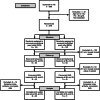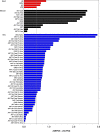Modeling relationships between iron status, behavior, and brain electrophysiology: evidence from a randomized study involving a biofortified grain in Indian adolescents
- PMID: 35794587
- PMCID: PMC9260997
- DOI: 10.1186/s12889-022-13612-z
Modeling relationships between iron status, behavior, and brain electrophysiology: evidence from a randomized study involving a biofortified grain in Indian adolescents
Erratum in
-
Correction: Modeling relationships between iron status, behavior, and brain electrophysiology: evidence from a randomized study involving a biofortified grain in Indian adolescents.BMC Public Health. 2022 Sep 2;22(1):1619. doi: 10.1186/s12889-022-13897-0. BMC Public Health. 2022. PMID: 36050753 Free PMC article. No abstract available.
Abstract
Background: Iron deficiency (ID) and iron deficiency anemia (IDA) are highly-prevalent nutrient deficiencies and have been shown to have a range of negative effects on cognition and brain function. Human intervention studies including measures at three levels-blood, brain, and behavior-are rare and our objective was to model the relationships among measures at these three levels in school-going Indian adolescents.
Methods: Male and female adolescents in rural India were screened for ID/IDA. Subjects consumed 2 meals/day for 6 months; half were randomly assigned to consume meals made from a standard grain (pearl millet) and half consumed meals made from an iron biofortified pearl millet (BPM). Prior to and then at the conclusion of the feeding trial, they completed a set of cognitive tests with concurrent electroencephalography (EEG).
Results: Overall, serum ferritin (sFt) levels improved over the course of the study. Ten of 21 possible measures of cognition showed improvements from baseline (BL) to endline (EL) that were larger for those consuming BPM than for those consuming the comparison pearl millet (CPM). Critically, the best model for the relationship between change in iron status and change in cognition had change in brain measures as a mediating factor, with both change in serum ferritin as a primary predictor and change in hemoglobin as a moderator.
Conclusions: A dietary intervention involving a biofortified staple grain was shown to be efficacious in improving blood iron biomarkers, behavioral measures of cognition, and EEG measures of brain function. Modeling the relationships among these variables strongly suggests multiple mechanisms by which blood iron level affects brain function and cognition.
Trial registration: Registered at ClinicalTrials.gov, NCT02152150 , 02 June 2014.
Keywords: Brain; Cognition; Electroencephalography; Iron deficiency; Memory.
© 2022. The Author(s).
Conflict of interest statement
The authors declare that they have no competing interests.
Figures




References
-
- Stevens GA, Finucane MM, De-Regil LM, Paciorek CJ, Flaxman SR, F. Branca F, Nutrition Impact Model Study Group Global, regional, and national trends in haemoglobin concentration and prevalence of total and severe anaemia in children and pregnant and non-pregnant women for 1995-2011: A Systematic analysis of population-representative data. Lancet Glob Health. 2013;1(1):e16–e25. doi: 10.1016/S2214-109X(13)70001-9. - DOI - PMC - PubMed
-
- Haas JD. The effects of iron deficiency on physical performance. Food and Nutrition Board, Institute of Medicine. Washington, DC: The National Academies Press; 2006.
Publication types
MeSH terms
Substances
Associated data
LinkOut - more resources
Full Text Sources
Medical

